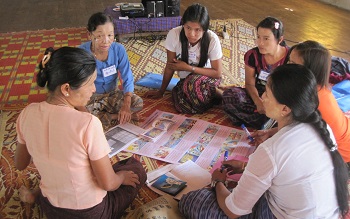Project
Empowered Civil Society Addressing the Democratic Needs of Rural Women in Myanmar
- Myanmar
- January 2016
The project’s objective was to strengthen institutional capacity of three independent CSOs working with rural women’s groups so that they could establish associations of self-help groups and promote inclusive participatory dialogue with authorities. Working from a UNDP model, the project focused on three aspects: transparency and accountability; rights awareness and advocacy; and linkages with other community-level groups.
The project was exemplary in its effectiveness, both in terms of the clarity of outcomes to be achieved (and activities to achieve them) and of quantitative and qualitative standards of achievement. It raised awareness of voters’ and women’s rights, and initiated engagement between local officials and rural communities. This is also an example of a project where sustainability was included in the design. The capacity building activities included supporting partner organizations achieve a degree of financial independence, by providing technical advice on project design and management, and by helping them develop internal governance and accountability systems.
Lessons from Project
💡
- Community activism
- Myanmar
- January 2016
It was hoped that engagement with local authorities on the part of newly capacitated groups would lead to policy advocacy. This was overly ambitious, and assumed that political reforms in Myanmar would move sufficiently towards autonomy for local authorities. The advocacy engaged in during the project concerned very specific administrative and livelihood issues, such as calls for household registration and national identity documents, road building and land allocation.
💡
- Community activism
- Myanmar
- January 2016
The capacity building activities explicitly included support towards achieving a degree of financial independence, by providing technical advice on project design and management, developing internal governance and accountability systems. In turn, the injection of project funds, together with sustained technical advice and mentoring have placed many of the target groups on course to achieve at least a degree of self-sufficiency.
💡
- Community activism
- Myanmar
- January 2016
The low education level of many villagers made it difficult to achieve required levels of capacity building. Partners noted that some participants were functionally illiterate. According to one, only about a third of women participants could read and write fluently. This required training methodologies based on personal interaction rather than written materials and outputs, and limited the number of people who could assume leadership positions.

💡
- Community activism
- Myanmar
- January 2016
The project correctly emphasized the need to build the capacity of women to take part in decision-making processes, but it could also have included an element addressing men, to encourage them to support women’s involvement in such processes. In the absence of engagement specifically directed at men, the project ran the risk of appearing to be solely a support mechanism for women.
💡
- Community activism
- Myanmar
- January 2016
Raising awareness among men about women’s rights is necessary to contribute to reducing some of the challenges faced by women who seek leadership roles in their community. The project contributed to changing men’s attitudes towards women’s role in the community: there was greater acceptance among men of women exercising a leadership role at local level, even though some men continued to note that this trend faces hostility.
💡
- Community activism
- Myanmar
- January 2016
The project approach and strategy were largely inspired by work done by UNDP since the 1990s in Myanmar, as part of its people-centered development approach. Several of the individuals who helped establish the partnerships on this project were former UNDP staff members. The years of experience in rural areas ensured that the project design addressed key needs in a realistic manner, adapted to the context.
💡
- Community activism
- Myanmar
- January 2016
The project was designed in close consultation with project partners. Their experience was taken into account, and they were the backbone of implementation. The, grantee’s role was focused on coordination, financial management and aspects of technical support. Partners’ long-standing experience working with rural women’s groups was a key element of project performance, because activities were designed in the light of past experience on aspects such as the size and composition of women’s groups, options for income generating activities.
💡
- Community activism
- Myanmar
- January 2016
A strong focus on the local – village and tract – in Myanmar made the project relatively independent of political developments at the national level, since activities such as capacity building could be carried out in a self-contained manner.
💡
- Community activism
- Myanmar
- January 2016
By addressing low-level officials at a technical level, the project further helped build the capacity of local government, thus addressing an additional need. Also, local officials were invited to participate on an equal footing in training sessions designed for community members.
💡
- Community activism
- Myanmar
- January 2016
By targeting district-based officials in charge of specific tasks, such as animal husbandry or cash crops, the project was able to engage officials in a dialogue in issues where there could be consensus While such officials were less powerful than district administrators; they were also more likely to address communities’ practical concerns.